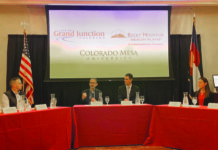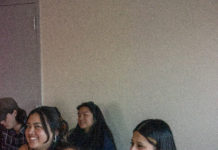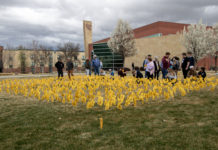by Alec Williams
Over the past decade, the CMU campus has grown into an always changing and evolving landscape. While the sight of construction irritates some commuting students, it also signals a seemingly infinite campus growth.
CMU’s University Center, Escalante Hall, Bunting Residence Hall, Wingate Residence Hall, Monument Residence Hall, the Maverick Center, North Avenue Residence Hall and several other buildings, renovations and updates have cropped up just in the past six years. Derek Wagner, vice president of intergovernmental and community affairs for CMU, attributes this to the appointment of university President Tim Foster and the university’s reorganizing efforts.
“Right after [Foster] got here was right after we got our own governing board. […] I think once they got President Foster here he really saw a vision and an opportunity to grow the institution both academically as well as our footprint in terms of the campus,” Wagner said. “With his leadership and being able to cast a vision, paint a picture of what the campus could look like, I think he did that and as they say, ‘The rest is history.’”
In 2011, the on-campus progress seemed to have eventually found a limit, however. An ever-increasing student population amplified the need for more academic buildings, student housing and parking.
CMU, which was then Mesa State College, set its sight westward to expand the campus to 7th Street. The plan was illustrated by the college in 2011, in a program plan entitled the “West Expansion Property Acquisition Project.”
“The specific additional property being considered by the College by its Foundation
consists of 214 residential lots, two churches, and 21 commercial properties comprising a
total of 77.3 acres. Other property that is being given to the College consists of city
streets and alleys that will become within the College boundaries,” the college wrote.
Of that property described, CMU has already purchased over 100 residential lots, many of which have been bulldozed to make way for parking lots. On Sept. 6, construction on CMU’s Computer Science and Engineering Building broke ground and took the place of many purchased homes on Elm Avenue.
The engineering building is also planned to bridge across 7th Avenue with a telescopic observatory. This past October, CMU reached a deal to purchase the three-acres property of the Seventh Day Adventist Church for $4 million. While the church will continue to use the property until at least 2018, the purchase had been in discussion for the past five years.
“It took that amount of time for us to get to the point where they were comfortable doing a deal, and we were at a point where we could do a deal,” Wagner said in a Grand Junction Daily Sentinel article from Oct. 2.
However, the plan to expand the campus onto 7th Avenue was not the college’s original idea, and was, in fact, an option offered by the local governments as an alternative.
“This goes back probably 30 years in our community when one of President Foster’s predecessors was interested in jumping across 12th Street and maybe expanding the campus over into the Lincoln Park area. There were folks at the time that didn’t like that idea in the community, so it really spurred a conversation amongst the city of Grand Junction, Mesa County, Mesa State College, at the time,” Wagner said. “[The city] said ‘We think it’d be great if you guys could grow your campus to the west, and someday be bookended by 12th Street on the east, 7th Street on the west, North Avenue on the south, and Orchard [Avenue] on the north. If you guys could grow that way that would be the best for the community.’”
Gradually, the university purchased the western properties, most notably homes towards 7th Avenue. The expansion does come with a cost, however, and while most of it falls on CMU’s wallet, the city of Grand Junction and Mesa County provide significant funding.
“As a city, thank you for playing a large role in the acquisition of these houses. And, you see that in just the last 10 years the [city’s] commitment of about $5 million along with the county in a million dollars. But, lest you think we’re just riding along, we’re, in fact, your partners and we have spent in excess $20 million in terms of acquiring these properties over that same 10-year period,” Foster said at a Grand Junction City Council meeting on Oct. 5. “So, we could not have done it without you, but, I don’t want to further the conspiracy theory that you’re carrying the entire load and that we’re free-loading on the backs of the city of Grand Junction.”
The city of Grand Junction continues to vocalize their support of university expansion despite the costs, as they believe a bigger, more advanced campus can provide larger opportunities for the city as a whole.
“I just want to reiterate thank you very much for your participation in our community, for the growth of the university and the vision to do so,” city council member Barbara Smith said to Foster at the Oct. 5 meeting.
For the CMU-owned houses that have not been bulldozed, some are used for university storage some remain empty and some are rented out by the school to students.
“If a house is in a location that we don’t have an immediate need we’ll try to rent it out through a property management agency – they manage it for us, and it provides a location close to campus for students that don’t want to be living in student housing,” Wagner said. “It gives us an opportunity to generate a little bit of revenue while we wait for something to be built right in that location.”
Bryce Hick, a sophomore at the university, is one of a few CMU students who rent out a university-owned home on Elm Avenue and has watched as houses across the street were converted into student parking.
“We used to have neighbors right across the street here,” Hick said. “All I know is that there’s 30-day notice before we need to get out of here if they ever do plan on tearing [our house] down. That’s the one thing I know that was through the university that I signed on my lease.”
Nonetheless, Hicks expressed a favorable opinion of the campus growth and enjoys the proximity of his home to school.
Mark and Mary Peterson, residents of 7th Avenue, have watched for the past couple decades as the university evolved and expanded into their neighborhood.
“Twenty years ago we were adamant we would not [sell],” Mary said.
“Originally, [CMU’s] intention 30 years ago was to go the other side of 12th Street,” Mark said. “Which to us made more sense because these were more single family, nice residential homes, but, since they started coming this way – which, I think is easier for [CMU] to do – […] You know, the neighborhood has changed.”
The Petersons expressed their disappointment in the rowdy environment the college has brought, along with student litter and late-night noise disturbances. Despite this, the Petersons have sold the multiple university properties over the years, always receiving a “fair” deal, and their children attended the college themselves.
As properties are continued to be purchased, CMU administration ponders the opportunities for the campus growth. While many students demand closer parking options, university representatives, including Wagner, have to consider the costs.
“There is envisioned some parking structures off of North Avenue, off of Orchard Avenue at some point in the future,” Wagner said. “The problem with those things is they’re really expensive.”
The university’s expansion, a slow, steady and costly process, may cause disturbance to the community, but continues to provide academic options for students. One of which is a “teaching hotel,” a student-run building that would function similar to the average hotel, but would reside on campus, administered by hospitality management students. Wagner would not disclose when such a building would join the campus but indicated a process is underway.
“We’re planning on it. We’re going through due diligence and trying to figure out how could we put those things together. We’ve got a consultant working with the feasibility study right now,” Wagner said. “We are going into this eyes wide open.”





